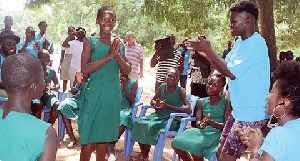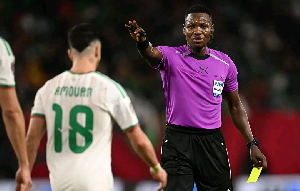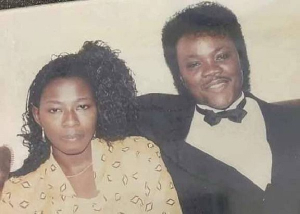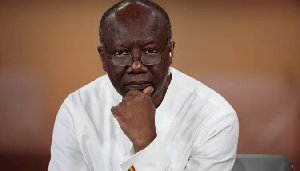It’s 6:45am at the Nima Cluster of Schools; Zeelia, Afia and Edem laugh heartily as they enter the compound, bypassing the ‘gateman’ stationed at the entrance to regulate the entry and exit of students.
“Good morning Baba,” they greeted as they went to join their colleagues to clean up their classroom before learning starts in the next 30 minutes. Today, I feel good I have come before classes starts. It is not like I am a late comer oo, but sometimes when I am in my ‘period’ it is difficult for me to do the things I normally do,” a form two student, Edem Agormeda, said.
For Edem and her two friends who will be sitting for the Basic Education Certificate Examination (BECE) next year, being present at school and actively engaging in academic activities means a lot to their educational pursuit.
But, biological requirement like their monthly menstruation from time to time disrupts their studies, making them unable to perform tasks both at school and at home properly.
“I get tired easily and I find it difficult to do household chores when I am in my ‘menses’,” Zeelia Yakubu stated.
“Me, when it comes, I cannot concentrate on my school work because I become weak,” added Afia Opoku.
This problem, according to the United Nations Children’s Fund (UNICEF), can be attributed to the low levels of red blood cells which are responsible for sending oxygen to the organs of the body.
This deficiency termed anaemia, among adolescent girls, is one of the most common public health problems in the world today.
It is caused by an inadequate intake of iron-rich foods like liver fish, meat and eggs as well as plant sources such as beans, ‘alaefu’ and ‘ayoyo’, oranges, lemons and baobab fruits which contain vitamin C, helpful in preventing anaemia.
The burden of anaemia disproportionately affects young children and women of childbearing age.
Globally, 43 percent of children under five, 38 percent of pregnant women, and 29 percent of non-pregnant women 15–49 years of age are anaemic (Stevens et al. 2013).
According to the study, anaemia is most widespread in Central and West Africa, where 71 percent of children under five years old, 48 percent of non-pregnant women, and 56 percent of pregnant women are affected.
Ghana’s Situation
UNICEF Ghana’s report on adolescent health indicates that close to one million out of the two million Ghanaian girls aged between 15 and 19 years are anaemic.
The report notes that girls who are anaemic due to menstruation and low intake or iron-rich foods generally get tired easily become weak and are unable to perform proper academic work leading to poor performance, as adolescence is a time of increased iron needs because of the expansion of blood volume and increases in muscle mass.
“Young women are at particular risk for the development of iron deficiency due to menstrual blood loss. In addition, adolescent athletes and adolescents who limit their intake of meat products are at risk. Iron deficiency affects both physical endurance and cognitive performance in adolescents,” the Reducing Anaemia in Ghana report by the USAID and SPRING revealed.
Thus, to curb the trend which affects the proper development of citizens, the Ghana Health Service (GHS), in partnership with development partners, over the years has rolled out and implemented nutrition programmes aimed at addressing iron deficiency among key populations, including children under five, pregnant women and adolescent girls.
The programmes employed behavioural change communication and distribution of iron and folic acid to key populations to shore up the micro-nutrients needed by the body to function properly.
Active activities were also encouraged among adolescent girls to keep them healthy and fit.
GIFTS Programme
One such programme is the National Girls Iron-Folic Acid Tablet Supplementation (GIFTS) programme launched by First Lady Mrs Rebecca Akufo-Addo.
GIFTS is aimed at providing drug supplements to women, adolescent girls and children to help reduce the prevailing high incidence of anaemia in the country.
The programme was designed to provide supplements to adolescent girls both in school and out of school aged between 10 to 19 years using a combined iron and folic acid tablet.
The first phase of the programme, which began in the Brong Ahafo, Northern, Upper East and Volta Regions, is expected to reach about 360,000 in-school adolescent girls and close to 600,000 out-of-school girls.
In her address at the launch, Mrs Akufo-Addo outlined the negative effects iron and folic acid deficiency has on adolescents.
She articulated that anaemia deprives adolescent girls of the ability to attain their fullest potential by limiting their development and learning ability, increase their vulnerability to dropping out of school and reducing their concentration in daily takes, physical fitness and work productivity.
“The best solution is to give them nutrient-rich food with additional meat, liver, chicken, egg and fish. Providing iron folate supplements routinely to these girls are the most immediate measures that have many health and developmental benefits,” she stated.
Adding his voice, the Director General of Ghana Health Service (GHS), Dr Anthony Nsiah-Asare, pointed out that anaemia in pregnancy is a key challenge in the country’s effort at reducing maternal mortality.
For his part, the Brong-Ahafo Regional Minister, Kwaku Asomah-Cheremeh, mentioned that the introduction of the GIFTS programme to help reduce the speed of anaemia is highly commendable.
He, however, entreated the organisers to deepen the education and sensitisation of the drug supplement in schools and health facilities to increase its patronage to help realise the desired effect.
These laudable initiatives, however, do not cover all adolescent girls in need of the intervention, hence his call for a scale-up of the GIFTS programme to ensure the country’s future develop to their full potential.
Influencing Adolescents
As part of deepening education to cause behavioural change among adolescents, UNICEF organised an influencers’ visit to the Kpandai District of the Northern Region to interact with students of the St Kizoti RC School.
The influencers – MzVee, Gary Al-Smith, Wiyaala and M.anifest – encouraged the students to strive for the best through education while sharing ideas on menstrual hygiene and iron deficiency.
The students, visibly elated and encouraged by the presence of their ‘stars’, gave insightful feedback on the GIFTS programme.
“First I was like this, but since I started taking the medicine see my body,” one of the students said jokingly to M.anifest, who was witnessing the distribution of the iron-folic acid tablet supplement.
Wiyaala, who hails from the region, shared her experience with the students, saying it is not easy at all growing up as a young girl in a deprived community, especially in the Northern Region of Ghana, “but If I have been able to do it they can also do it with a little push.”
Emmanuel Ansuban, a student, who has been enlightened by the open conversation on menstrual hygiene with MzVee, agreed to the fact that knowledge about menstrual hygiene is important.
“It is important for we the boys to also know about menstrual hygiene because as we are growing, we will surely become fathers and as young people who have sisters, we need to assist when they are young. What they can do we can also do, we can cook, we can wash bowls, we have to assist them to also have enough time to learn,” he advised.
The ‘Ampe Challenge’ was introduced to reinforce the message that exercise is good and to allow the adolescent girls to exercise.
Opinions of Sunday, 10 June 2018
Columnist: Jamila Akweley Okertchiri















